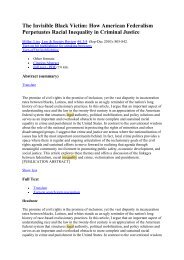Beyond the Qualitative Interview: Data Preparation and ... - E-Journal
Beyond the Qualitative Interview: Data Preparation and ... - E-Journal
Beyond the Qualitative Interview: Data Preparation and ... - E-Journal
You also want an ePaper? Increase the reach of your titles
YUMPU automatically turns print PDFs into web optimized ePapers that Google loves.
McLellan et al. / DATA PREPARATION 73<br />
Training data managers, transcribers, <strong>and</strong> proofreaders is highly variable<br />
given <strong>the</strong> research structure, <strong>the</strong> setting, <strong>the</strong> type <strong>and</strong> volume of data collected,<br />
<strong>the</strong> data produced, <strong>and</strong> <strong>the</strong> analytical approach taken. Hence, training<br />
must be tailored to fit <strong>the</strong> research. Minimally, all persons h<strong>and</strong>ling audiotapes<br />
<strong>and</strong> transcripts should be thoroughly familiar with <strong>the</strong> specific procedures<br />
for processing “raw“ <strong>and</strong> “prepared“ data, be able to demonstrate a<br />
consistent application of such principles, <strong>and</strong> know how to document exceptions<br />
(Kelle, Prein, <strong>and</strong> Bird 1995; MacQueen <strong>and</strong> Milstein 1999). In our<br />
studies, despite emphasis on generating verbatim accounts, we recognize<br />
that <strong>the</strong> text must also be readable. While “ums,” “ahs,” “uh huhs,” <strong>and</strong> “you<br />
knows” are retained, linguistic- or phonetic-type transcripts are not produced.<br />
Because transcripts must be made accessible to our collaborators,<br />
conventional transcription symbols are not used. Silverman (1998:264) provided<br />
a simplified set of transcription symbols appropriate for transcripts that<br />
need to include <strong>the</strong> precise lengths of pauses, verbal stresses, overlapping<br />
talk, <strong>and</strong> interviewer or analyst descriptions ra<strong>the</strong>r than transcriptions.<br />
Even <strong>the</strong> most proficient transcriber misses a word or two or transcribes<br />
some phrases that are slightly different from what was actually said (Weiss<br />
1994:199). Therefore, it is necessary to proofread all or a r<strong>and</strong>om selection of<br />
transcripts. In our transcription protocol, transcribers <strong>and</strong> proofreaders are<br />
instructed to transcribe “inaudible text segment” if portions of <strong>the</strong> audiotape<br />
are inaudible or unintelligible. When interviewer <strong>and</strong> interviewee are simultaneously<br />
talking, <strong>and</strong> distinct comments are indecipherable, <strong>the</strong> phrase<br />
“cross talk” is inserted.<br />
If only a subset of <strong>the</strong> transcripts is to be proofread, it is extremely important<br />
that <strong>the</strong> first two or three transcripts prepared by a transcriber undergo<br />
careful review. O<strong>the</strong>rwise, problems may go unnoticed until analysis is well<br />
under way, at which point it may be difficult <strong>and</strong> time consuming to correct<br />
transcription errors. Unless a formatting problem is present, <strong>the</strong>re may be no<br />
obvious indication that a transcript inaccurately reflects what was actually<br />
said in an interview. This is why it is important to always check <strong>the</strong> transcript<br />
against <strong>the</strong> audiotape. The use of digital audio recordings permits <strong>the</strong> indexing<br />
of transcripts with “time markers.” Maloney <strong>and</strong> Paolisso (2001:92) recommended<br />
that <strong>the</strong> top of each new page include this time stamp to support<br />
<strong>the</strong> quick retrieval of an audio component that matches <strong>the</strong> transcribed text. If<br />
a researcher decides to proofread a selection of transcripts, it is important that<br />
<strong>the</strong> tapes or digital audio files be retained for reference. As noted previously,<br />
this in turn may result in confidentiality issues, <strong>and</strong> <strong>the</strong>se must be balanced<br />
against efforts to cut transcription costs.














